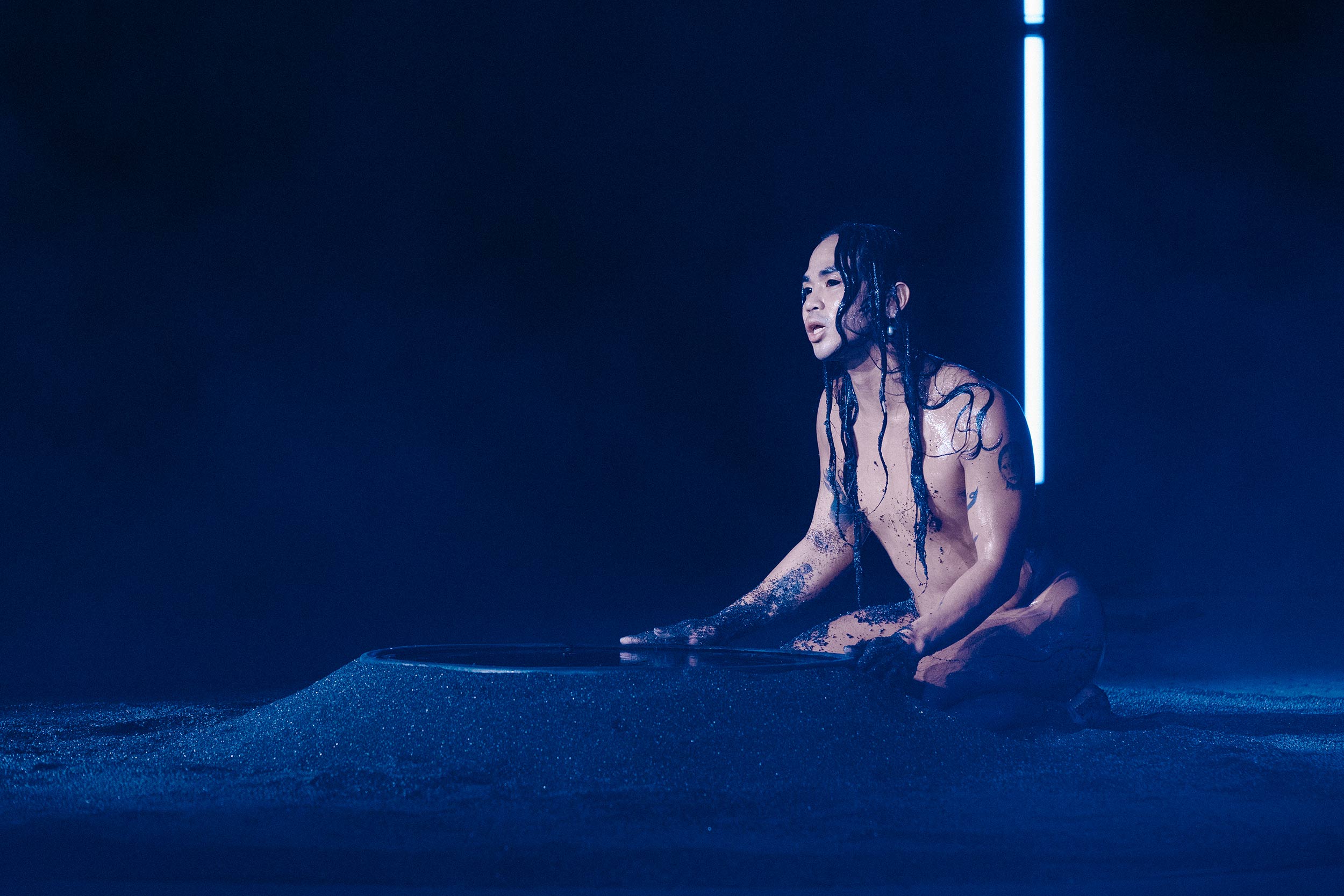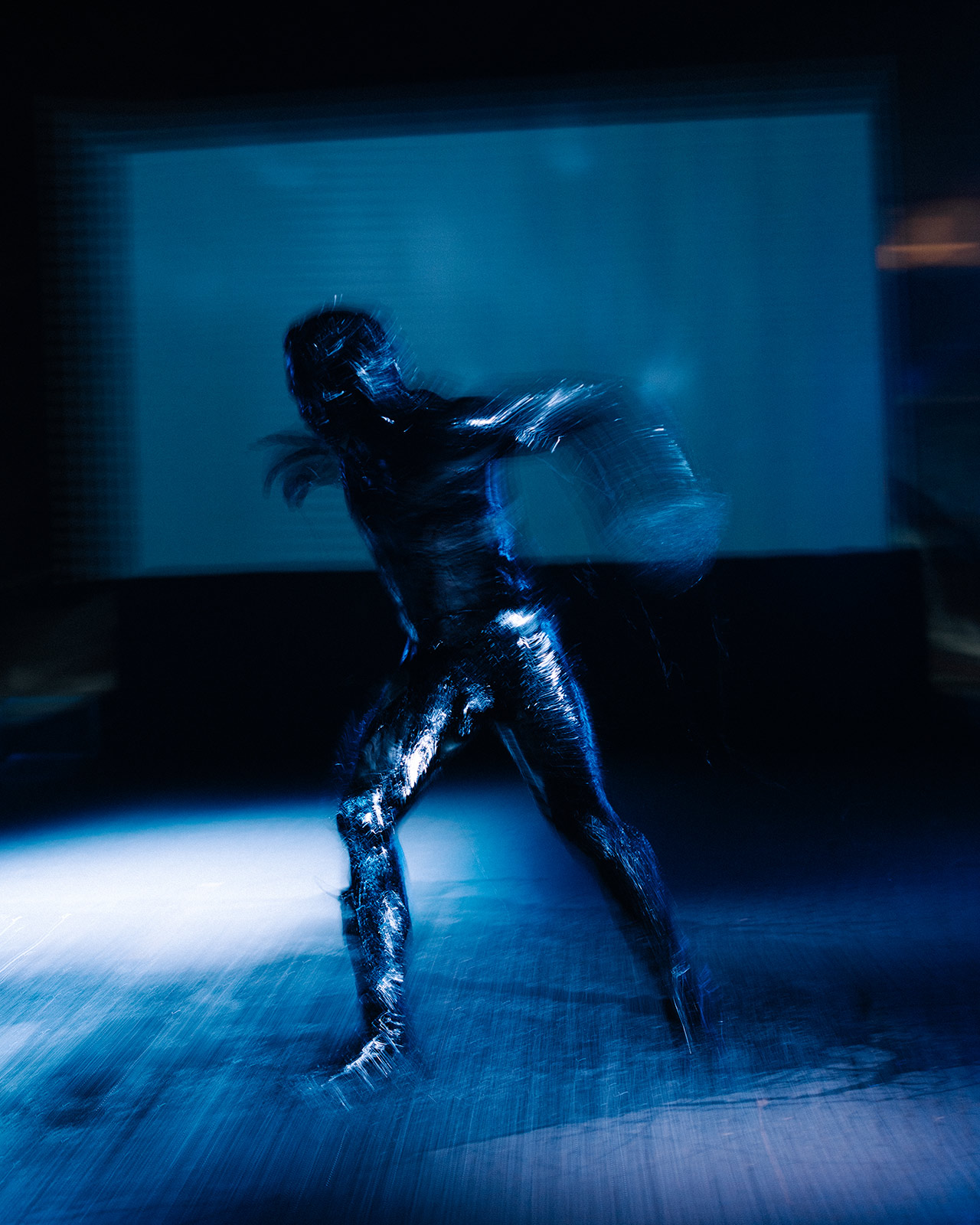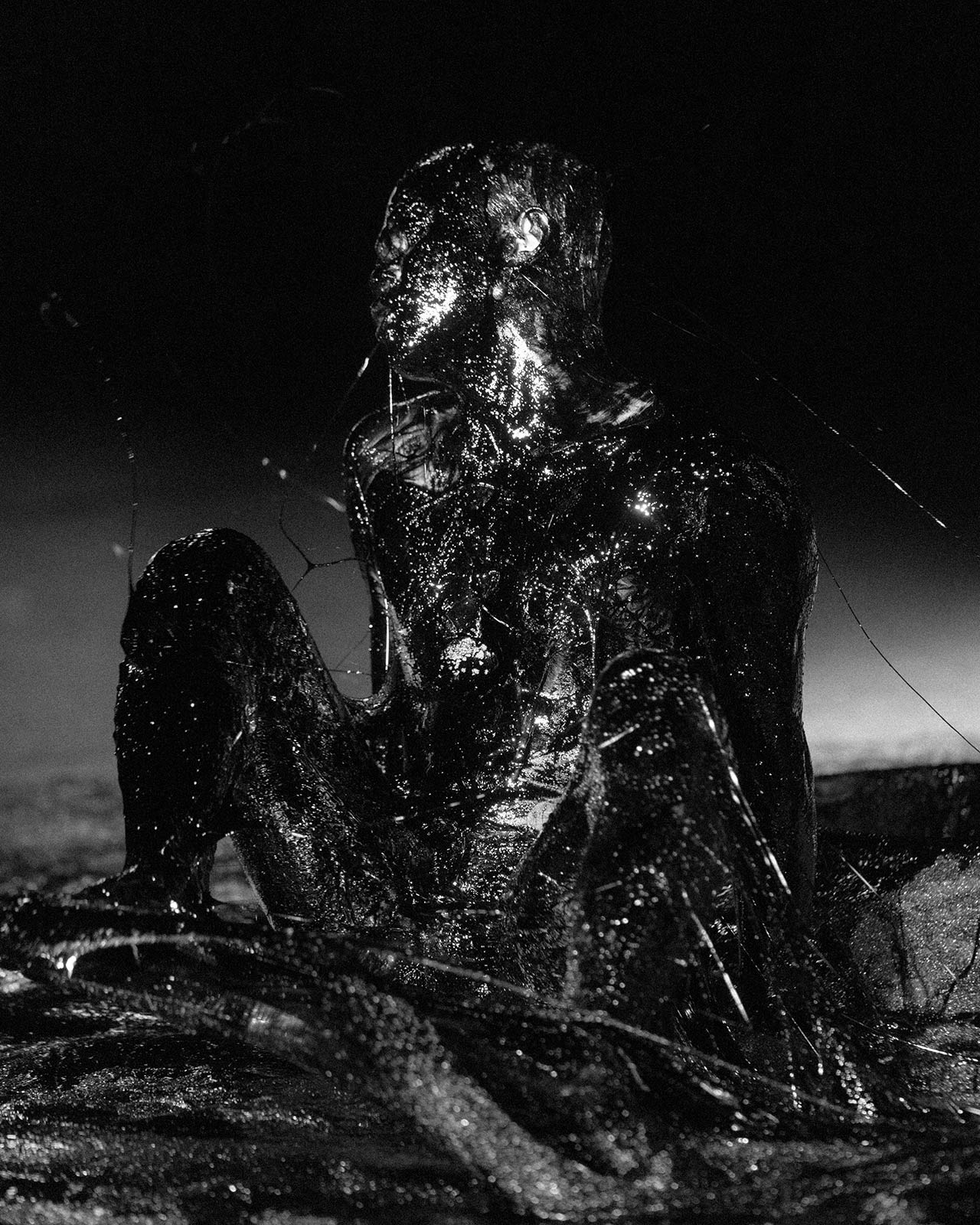Document joins the artist to discuss the speculative future realms of Indigenous Filipino spirituality in their most recent video installation and live performance
In VOID, a video installation and live performance created by the multidisciplinary artist Joshua Serafin, the past, present, and future coalesce. Inspired by spiritual backgrounds in a pre-colonial society in the Philippines, Serafin’s work centers around the creation of Void, a god for the future, who also happens to inhabit our present-day world. Void’s movements through time and space are meant to symbolize the sadness that plagues our contemporary climate. But Serafin’s work is not without hope. The piece transforms the way we speculate about the future by imagining what it might be like for a god to join the mortal realm to understand humans.
It has been a busy few years for Serafin, who was born in the Philippines and is now based in Brussels. They are currently a house artist at Belgian art center Viernulvier for the 2023–27 season. VOID was performed at TONO festival in Mexico City in March as well as the Venice Biennale in April. The video installation version of the piece is currently on view in the Arsenale at the Venice Biennale as well as at Amant in New York. It is no wonder that their performance pieces pay such close attention to place, often exploring transmigration, global ideology, as well as Filipino identity. Yet despite all their travels, Serafin’s vantage point is one that resists any kind of fixed temporalities or geographies. Instead, they linger within interstitial spaces, focusing their attention on what it means to inhabit the in-between.
TONO Festival Artistic Director Sam Ozer joins Serafin in a conversation surrounding ancestral lands, indigenous communities, and the unseen realm.
Sam Ozer: VOID is part of your Cosmological Gangbang constellation of works, a series of works that reference spiritual histories in the Philippines to create new consciousness around fluidity and gender belief systems. Were you aware of these mythologies and stories growing up? Or, were these things you became more interested in once you had moved to Europe and had some distance from home?
Joshua Serafin: My mom was my source for these stories. She is very superstitious and has a faith healer and a traditional healer. Mythology, spirituality, and the unseen realm is also very rooted in Filipino culture. After living in Europe for many years, I realized that I wanted to explore this and consider what my positionality is with the air and the earth. When Patrick Flores invited me to participate in VIVA Excon, which is a biennial in the Philippines located in my region, this chapter really began.
Sam: When was that?
Joshua: This was early 2021. I returned to the stories from my childhood and also began research through Filipino literature and archival research to ask what else is there besides my own history and relationship to mythology?
Sam: You also went into the mountains and spent time with some indigenous communities.
Joshua: Yes, it was very important for me to go back to ancestral lands and speak with communities who are close to this knowledge. I spent time with the Manobo and Talaandig tribes in Bukidnon. I met the shaman and tribe chieftain Datu Arayan and his community. He is this amazing, clairvoyant human being, who is also queer. Before I left the community, I showed Arayan images of VOID and explained that this was a performance I was working on. He gasped and shared that my spirit guide looked exactly the same.
In his understanding of the universe there is the underworld and the upperworld; however, there is no notion of good or bad. Spirit guides are powerful beings that live in the underworld and it was crazy to hear that mine looks like VOID. It was a bit of a revelation to hear this with my collaborators Bunny [Cadag] and Lukresia there too. In a way, this visit and speaking with a community that lives and practices rituals around this knowledge allowed us to feel justified as queer beings. As artists, we are always trying to create things, so it was beautiful to learn that we are so in touch with ourselves that we’re actually tapping into a spirituality that is already present in our lives and manifesting spiritual guides in our performances.
Sam: For Arayan, what is the relationship between the spirit and the body?
Joshua: A spirit is an infinite being that lifts into different cosmos. I received this story that when you give birth to a child and the first breath is a cry, it’s because it cries for the life that it had. It mourns for that life. Because it’s a new time, a new life, you don’t remember the past because you are living in a new realm, but there is still this connection to it. Which I find beautiful. While I had never met Orion before, he said that we had met in a past life. He explained that we were both killed at the same time. We were both beheaded because we had a lot to say—to fight injustice and to liberate bodies. Today, we have the same energies.
“I think rest is very important because if I’m in a liminal or limbo space where I’m not working, ideas come. If I’m in a space of transiting, like in a plane, that’s where I dream a lot.”
Sam: This feeling of the transfer of energy through generations and geographies I think was really present during your performance in Mexico City as part of TONO. I was excited to present your work at the Cárcamo de Dolores museum in Chapultepec park, as there were so many beautiful moments between your performance and embodiment of the futuristic god Void that you have created in your universe and Tlaloc, the Aztec god of water who was present in the Cárcamo as a mosaic design by Diego Rivera. There was this peaceful moment at the beginning of the performance when both yours/Void’s pools and Tlaloc’s were shining in the moonlight, which was shattered when you broke the seal of the goo and started dancing and flinging it around the plaza. It felt as if you were breaking the space between two realms—creating this connection between a Mexican and Filipino geography and belief systems.
When you performed at the Venice Biennale, VOID had a different relationship to the architecture and also a connection with the lagoons right outside, and of course the storied history of the exhibition and Venice as a city. What was your experience of these different presentations?
Joshua: VOID was first made in an abandoned swimming pool. So the nature of the work corresponds to where it is and the architecture adds to the layer of the performativity and the experience of the viewer. In Mexico, it was spiritually charged because of the histories of Diego Rivera and Tlaloc and this idea of Void as a new god.
VOID is an open piece that doesn’t directly propose but rather allows the viewer to add context and open themselves up to different imaginaries and readings. In Venice, I was in a constant high. The production of the performance was a beautiful experience. And my video installation [in the Arsenale] was how I’ve always dreamt it would be shown—the space becomes its own world.
Sam: It really was this beautiful cave of its own. What happens to Void now?
Joshua: I want to develop the life of Void and for it to become a bigger world and to expand into more characters but also different articulations on film, in installation, and in performance. I’m now writing a durational performance that activates the whole experience. But I’m also resting.
Sam: As your work is so deeply connected with time, how does rest factor into your process and production? Are you quite strict about periods of rest?
Joshua: I think rest is very important because if I’m in a liminal or limbo space where I’m not working, ideas come. If I’m in a space of transiting, like in a plane, that’s where I dream a lot. Surfing, for example, where I’m in nature, where I’m not restrained to production or time, where I’m in this space of just me with myself, with the sun and the sea, that’s where I actually articulate most of my ideas. I also realized now I need to rest to be able to dream again.
I’m asking myself, Where am I now? What does the world need? Where do we want to go? The cosmology was developed over three years and was very inspired by my childhood until this phase of my life now, so I need to find out who I am again in this moment.
Sam: In this process, how does place inform your work? You spoke about the site-specificity of performances, but how about the dreaming and the research?
Joshua: I go back to the Philippines to articulate certain things. I also have a lot of interest in going back to Mexico and to Brazil and Latin America more broadly. I feel like there’s a long lost intergenerational Pacific lineage that has existed that I felt I haven’t uncovered. When I was in Mexico, it felt like the Philippines. There was a gut feeling of familiarity there that I want to explore. I have family in America and am curious about spending time there. My great-grandfather was Japanese, so I have been very curious about tracing those histories and am working on a new cosmology from this.
Sam: Can you share more details?
Joshua: I’m still writing it, but it’s called Lost Ancestors. The project retraces lives and stories that have been diminished by disruption in time, which, for humanity, is usually war. I’m interested in lineages that are no longer accessible because there is no trace of humanity. What happens to these stories? What happens to these bodies? What do they become?
In my own family, I don’t know who my great-grandfather was. He came to the Philippines during the Japanese occupation and we don’t have any records of who he was. Historically, who are we as Filipinos? Or how far can we go to trace our ancestry? In the Global South, you can’t really trace beyond four or five generations because of colonization.
Sam: Are you going to try to trace specifically who your grandfather was, or more in an emotive sense of discovering what he represents as a person rather than him specifically?
Joshua: I am actually trying to discover who he was. First, I have to begin research in the Philippines to find documents of who he was, then go to Japan and actually find it in the registry. All of the information I have is from oral histories, so it’s a different form of record keeping.
Sam: Language and storytelling then becomes a very interesting part of this process.
Joshua: My experience with the indigenous communities when researching VOID is also really informative for this project. It was beautiful as a Filipino, as a human, to discover stories about my ancestral selves that goes beyond time that I could see. I want to continue to ask Who am I? Who were we?















